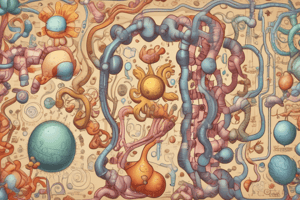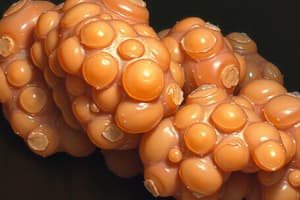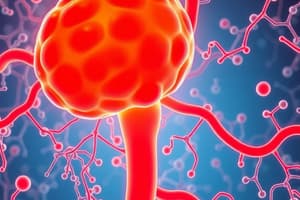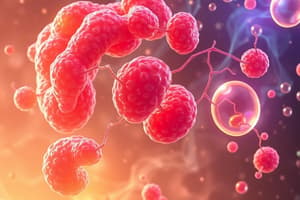Podcast
Questions and Answers
Why are triglycerides considered effective for energy storage?
Why are triglycerides considered effective for energy storage?
- They have a low molecular weight, enabling cells to store large quantities of them.
- They contain a high ratio of carbon-hydrogen bonds, which release energy upon oxidation. (correct)
- They are highly soluble in water, allowing for easy transport and breakdown.
- They are easily converted into glucose for immediate energy use.
What is the primary role of phospholipids in cells?
What is the primary role of phospholipids in cells?
- Long-term energy storage.
- Catalyzing metabolic reactions.
- Structural components of cellular membranes. (correct)
- Transporting oxygen throughout the cell.
How does cholesterol contribute to cellular function?
How does cholesterol contribute to cellular function?
- Acting as a precursor for synthesizing all types of lipids.
- Serving as the primary source of energy for cellular processes.
- Facilitating the transport of water-soluble molecules across the cell membrane.
- Modulating membrane fluidity and acting as a precursor for steroid hormone synthesis. (correct)
What is the metabolic fate of cytosolic fatty acyl-CoA?
What is the metabolic fate of cytosolic fatty acyl-CoA?
What is the function of the carnitine shuttle in fatty acid metabolism?
What is the function of the carnitine shuttle in fatty acid metabolism?
How does malonyl-CoA regulate fatty acid metabolism?
How does malonyl-CoA regulate fatty acid metabolism?
What is the role of acyl-CoA dehydrogenase in beta-oxidation?
What is the role of acyl-CoA dehydrogenase in beta-oxidation?
What is the function of the enzyme ETF:ubiquinone oxidoreductase?
What is the function of the enzyme ETF:ubiquinone oxidoreductase?
What is the role of thiolase in beta-oxidation?
What is the role of thiolase in beta-oxidation?
What is the net ATP production from each FADH2 molecule that donates electrons to the respiratory chain?
What is the net ATP production from each FADH2 molecule that donates electrons to the respiratory chain?
What is unique about fatty acid oxidation in peroxisomes compared to mitochondria?
What is unique about fatty acid oxidation in peroxisomes compared to mitochondria?
Under what physiological conditions are ketone bodies produced in significant quantities?
Under what physiological conditions are ketone bodies produced in significant quantities?
What is the function of HMG-CoA lyase and HMG-CoA synthase in relation to ketone bodies?
What is the function of HMG-CoA lyase and HMG-CoA synthase in relation to ketone bodies?
Why can't the liver utilize ketone bodies as fuel?
Why can't the liver utilize ketone bodies as fuel?
What are the two precursors shared by triacylglycerols and glycerophospholipids?
What are the two precursors shared by triacylglycerols and glycerophospholipids?
How is glycerol 3-phosphate formed?
How is glycerol 3-phosphate formed?
What role do acyltransferases play in the synthesis of triacylglycerols?
What role do acyltransferases play in the synthesis of triacylglycerols?
What is phosphatidic acid, and how is it related to the synthesis of triacylglycerols and glycerophospholipids?
What is phosphatidic acid, and how is it related to the synthesis of triacylglycerols and glycerophospholipids?
Where does glycerophospholipid synthesis primarily occur in eukaryotic cells?
Where does glycerophospholipid synthesis primarily occur in eukaryotic cells?
What are the two strategies by which cells attach phospholipid head groups?
What are the two strategies by which cells attach phospholipid head groups?
Why are the phospholipid biosynthetic pathways considered to be interrelated?
Why are the phospholipid biosynthetic pathways considered to be interrelated?
What function is uniquely associated with cardiolipin?
What function is uniquely associated with cardiolipin?
How are lipids transported given they are insoluble in water?
How are lipids transported given they are insoluble in water?
Which lipid (fat) is usually subcutaneous and provides thermal insulation?
Which lipid (fat) is usually subcutaneous and provides thermal insulation?
True or false: Lipids can only come from the diet.
True or false: Lipids can only come from the diet.
In fatty acid nomenclature, what part of the molecule does the 'n' refer to?
In fatty acid nomenclature, what part of the molecule does the 'n' refer to?
Which of the following is a component of storage lipids and membrane lipids? (See the Minecraft Lipid Depiction figure)
Which of the following is a component of storage lipids and membrane lipids? (See the Minecraft Lipid Depiction figure)
True or false: In the cytosol, most of the fatty acids are bound to Fatty Acid Binding Protein (FABP).
True or false: In the cytosol, most of the fatty acids are bound to Fatty Acid Binding Protein (FABP).
What is the purpose of activating fatty acids to fatty acyl-CoAs??
What is the purpose of activating fatty acids to fatty acyl-CoAs??
What is the overall reaction for fatty acyl-CoA formation?
What is the overall reaction for fatty acyl-CoA formation?
Choose the options that list possible fates for cytosolic fatty acyl-CoA.
Choose the options that list possible fates for cytosolic fatty acyl-CoA.
How are cytosolic fatty acids transported into the mitochondria?
How are cytosolic fatty acids transported into the mitochondria?
What must occur for a fatty acid (> 14C) to enter the carnitine shuttle?
What must occur for a fatty acid (> 14C) to enter the carnitine shuttle?
Which enzyme converts acyl-CoA to an acyl-carnitine?
Which enzyme converts acyl-CoA to an acyl-carnitine?
Which enzyme resynthesizes an acyl-CoA from an Acyl-carnitine in the matrix?
Which enzyme resynthesizes an acyl-CoA from an Acyl-carnitine in the matrix?
Choose the correct order of the three stage of catabolism?
Choose the correct order of the three stage of catabolism?
Which of these is the correct four-step process for stage 1 of fatty acid catabolism?
Which of these is the correct four-step process for stage 1 of fatty acid catabolism?
What does it mean for trifunctional protein (TFP) to 'allow efficient substrate channeling'?
What does it mean for trifunctional protein (TFP) to 'allow efficient substrate channeling'?
Which of the following is NOT a ketone body?
Which of the following is NOT a ketone body?
True or false: The liver produces ketone bodies, but the brain cannot.
True or false: The liver produces ketone bodies, but the brain cannot.
In which organ are ketone bodies formed?
In which organ are ketone bodies formed?
Which of these best describes how 'Strategy 1' occurs to synthesize Glycerophospholipids?
Which of these best describes how 'Strategy 1' occurs to synthesize Glycerophospholipids?
True or False: Phosphatidylserine, phosphatidylethanolamine, and phosphatidylcholine all begin with the same CDP-diacylglycerol?
True or False: Phosphatidylserine, phosphatidylethanolamine, and phosphatidylcholine all begin with the same CDP-diacylglycerol?
In eukaryotes, describe where glycerophospholipids are primarily synthesized
In eukaryotes, describe where glycerophospholipids are primarily synthesized
Flashcards
What is a triglyceride?
What is a triglyceride?
A glycerol esterified to three fatty acids; it serves as energy storage and provides thermal insulation.
What is a phospholipid?
What is a phospholipid?
Glycerol esterified to two fatty acids and a head group; they form membranes and mediate intracellular signaling.
What is cholesterol?
What is cholesterol?
Lipids that act as membrane components and are precursors to steroid hormones for cell signaling.
Where do lipids come from?
Where do lipids come from?
Signup and view all the flashcards
What are essential fatty acids?
What are essential fatty acids?
Signup and view all the flashcards
What is a triacylglycerol?
What is a triacylglycerol?
Signup and view all the flashcards
What are membrane lipids?
What are membrane lipids?
Signup and view all the flashcards
Why are triglycerides good energy storage molecules?
Why are triglycerides good energy storage molecules?
Signup and view all the flashcards
What does serum albumin do?
What does serum albumin do?
Signup and view all the flashcards
What transports fatty acids in blood?
What transports fatty acids in blood?
Signup and view all the flashcards
What are fatty acids activated to?
What are fatty acids activated to?
Signup and view all the flashcards
What are fatty acyl-CoA synthetases?
What are fatty acyl-CoA synthetases?
Signup and view all the flashcards
What are the fates of cytosolic fatty acyl-CoA?
What are the fates of cytosolic fatty acyl-CoA?
Signup and view all the flashcards
What does the carnitine shuttle do?
What does the carnitine shuttle do?
Signup and view all the flashcards
What enzymes facilitate the carnitine shuttle?
What enzymes facilitate the carnitine shuttle?
Signup and view all the flashcards
Describe the carnitine shuttle's role.
Describe the carnitine shuttle's role.
Signup and view all the flashcards
What are the three stages of fatty acid oxidation?
What are the three stages of fatty acid oxidation?
Signup and view all the flashcards
List the enzymes of beta-oxidation
List the enzymes of beta-oxidation
Signup and view all the flashcards
What does acyl-CoA dehydrogenase do?
What does acyl-CoA dehydrogenase do?
Signup and view all the flashcards
What is ETF: CoQ oxidoreductase?
What is ETF: CoQ oxidoreductase?
Signup and view all the flashcards
What does the trifunctional protein do?
What does the trifunctional protein do?
Signup and view all the flashcards
Overall reaction for one pass of beta oxidation?
Overall reaction for one pass of beta oxidation?
Signup and view all the flashcards
What is the overall reaction for Stage 1 of Beta Oxidation?
What is the overall reaction for Stage 1 of Beta Oxidation?
Signup and view all the flashcards
How much energy is produced from electron transfer?
How much energy is produced from electron transfer?
Signup and view all the flashcards
What happens to Acetyl-CoA in oxidation?
What happens to Acetyl-CoA in oxidation?
Signup and view all the flashcards
How is fatty acid oxidation inhibited?
How is fatty acid oxidation inhibited?
Signup and view all the flashcards
Name some ketone bodies?
Name some ketone bodies?
Signup and view all the flashcards
What does thiolase do?
What does thiolase do?
Signup and view all the flashcards
What does HMG-CoA synthase do?
What does HMG-CoA synthase do?
Signup and view all the flashcards
What does D-β-hydroxybutyrate dehydrogenase do?
What does D-β-hydroxybutyrate dehydrogenase do?
Signup and view all the flashcards
What is glycerol-3-phosphate?
What is glycerol-3-phosphate?
Signup and view all the flashcards
What do acyl-CoA synthetases do?
What do acyl-CoA synthetases do?
Signup and view all the flashcards
Where does GPL synthesis occur?
Where does GPL synthesis occur?
Signup and view all the flashcards
How are GPL in mammalian membraes remodeled
How are GPL in mammalian membraes remodeled
Signup and view all the flashcards
How do membrane lipids travel to intracellular destinations
How do membrane lipids travel to intracellular destinations
Signup and view all the flashcards
What impacts membrane structure and function?
What impacts membrane structure and function?
Signup and view all the flashcards
Why is cardiolipin important?
Why is cardiolipin important?
Signup and view all the flashcards
Study Notes
- Fatty acid metabolism covers lipid transport, fatty acid catabolism, triglyceride synthesis, and glycerophospholipid synthesis
Minecraft Depiction
- Key fatty acid-containing biological molecules can be categorized into storage lipids and membrane lipids
- Storage lipids include triacylglycerols, which contain glycerol esterified with three fatty acids
- Membrane lipids include glycerophospholipids, sphingolipids, galactolipids, archaeal ether lipids, and sterols
Important Fats
- Triglycerides are a glycerol esterified to three fatty acids, and function for energy storage in adipocytes and muscle lipid droplets, as well as providing thermal insulation and physical protection
- Phospholipids consist of a glycerol esterified to two fatty acids and one head group, found in membranes and involved in intracellular signaling
- Cholesterol is found in membranes and produces steroid hormones for signaling
Important Facts
- Lipids come from the diet or can be synthesized from glucose or amino acids
- Essential fatty acids like linoleic acid and alpha-linolenic acid must be obtained through diet
- Lipid metabolism varies among cell types
- Fatty acids are the primary metabolic fuel for heart and skeletal muscle at rest
- The brain uses ketone bodies derived from fatty acid oxidation in the liver, not fat directly
Fatty Acid Nomenclature
- In fatty acid nomenclature, carbon atoms are numbered, with the carboxyl group carbon as number 1 and the methyl group carbon designated as ω
- Fatty acids are named based on the number of carbons, number of double bonds, and the position of the first double bond from the methyl end
Dietary fatty acids
- Dietary fatty acids include caprylic (C8:0), capric (C10:0), lauric (C12:0), myristic (C14:0), palmitic (C16:0), palmitoleic (C16:1), stearic (C18:0), oleic (C18:1), linoleic (C18:2), and α-linolenic (C18:3) acids
- Common sources of fatty acids include coconut oil, palm oil, milk fat, animal fats, marine oils, and seed oils
Lipid transport
- Fats can be synthesized or acquired through diet
- Bile salts emulsify dietary fats in the small intestine, forming mixed micelles
- Intestinal lipases degrade triacylglycerols
Transported Fats
- Fatty acids and other breakdown products are absorbed by the intestinal mucosa, and are converted into triacylglycerols
- Triacylglycerols, cholesterol, and apolipoproteins are incorporated into chylomicrons
- Chylomicrons move through the lymphatic system and bloodstream
- Lipoprotein lipase, activated by apoC-II in the capillary, converts triacylglycerols to fatty acids and monoacylglycerols
- Fatty acids enter cells and are oxidized or re-esterified for storage
Lipoproteins
- Lipoproteins transport lipids in the bloodstream and include chylomicrons, very-low-density lipoproteins (VLDL), low-density lipoproteins (LDL), and high-density lipoproteins (HDL)
- Lipoproteins contain triacylglycerols, cholesterol, phospholipids, and apolipoproteins
Serum Albumin
- Serum albumin is a blood protein produced by hepatocytes that non-covalently binds and transports up to 7 FFAs (free fatty acids)
- Serum albumin accounts for about half of the total blood serum protein
Fatty acids in blood
- Fatty acids have low solubility in blood and cytosol, which necessitates transporter proteins
- Lipoproteins transport various lipids, while albumin carries non-esterified fatty acids
Fatty Acids from blood
- Bulk fluid flow from plasma to the interstitial space brings albumin close to muscle fibres
- Cellular fatty acid uptake involves dissociation from albumin, diffusion through interstitial fluid, insertion into the outer leaflet of the phospholipid bilayer, flip-flop to the inner leaflet, diffusion through cytosol, and binding to fatty acid binding protein (FABP) in cytosol
Fatty Acid Transporters
- Fatty acids enter cells via routes involving passive diffusion or facilitated transport by proteins like FABPpm, CD36, and FATP
- Intracellular fatty acids are bound to FABP and activated to fatty acyl-CoAs
Fatty acyl-CoA synthetase
- Fatty acyl-CoA synthetase isozymes are present in the outer mitochondrial membrane (and elsewhere), catalyzing both steps of the fatty acid activation reaction
- The overall reaction for fatty acyl-CoA formation involves three steps: two-step formation of the fatty acyl-CoA derivative, and the hydrolysis of the pyrophosphate created
- The overall reaction equation is: fatty acid + CoA + ATP ⇌ fatty acyl-CoA + AMP + 2Pi (∆G'° = −34 kJ/mol)
After Production
- Cytosolic fatty acyl-CoA can be used to make triglyceride for storage in adipocytes and muscle cells, used to make phospholipids, used to make cholesterol, or catabolized
Carnitine Shuttle
- Long-chain fatty acids (14+ carbons) are transported into mitochondria as carnitine esters via the carnitine shuttle, requiring activation to a fatty acyl-CoA and subsequent attachment to carnitine
- The carnitine shuttle involves carnitine acyl-transferase 1 (CAT1), an acylcarnitine/carnitine cotransporter, and carnitine acyl-transferase 2 (CAT2)
- CAT1 converts acyl-CoA to acyl-carnitine in the mitochondrial outer membrane and cytosol
- An Acylcarnitine/carnitine cotransporter exchanges a mitochondrial carnitine for a cytosolic (intermembrane space) acyl-carnitine
- CAT2 resynthesizes an acyl-CoA from an acyl-carnitine in the matrix
- Carnitine-mediated entry is a rate-limiting step and a major control point for fatty acid oxidation in mitochondria
- Carnitine acyltransferase 1 is inhibited by malonyl-CoA, preventing simultaneous synthesis and degradation of fatty acids
Fatty Acid Oxidation Stages
- Stage 1: β oxidation involves the oxidative removal of successive two-carbon units from fatty acids in the form of acetyl-CoA
- Stage 2: oxidation of acetyl-CoA groups to CO2 in the citric acid cycle
- Stage 3: electron transfer chain and oxidative phosphorylation
Stage 1: Enzymatic reactions
- Step 1 is catalyzed by acyl-CoA dehydrogenase, which involves dehydrogenation of fatty acyl-CoA to yield a trans-Δ2-enoyl-CoA
- Step 2 is catalysed by enoyl-CoA hydratase, where water is added across the double bond of the trans-Δ2-enoyl-CoA to form L-β-hydroxyacyl-CoA
- Step 3 is catalysed by β-hydroxyacyl-CoA dehydrogenase, where L-β-hydroxyacyl-CoA is dehydrogenated to form β-ketoacyl-CoA
- Step 4 is catalysed by acyl-CoA acetyl-transferase (thiolase), where β-ketoacyl-CoA reacts with free coenzyme A to yield acetyl CoA and a fatty acyl-CoA shortened by two carbons
ETF
- ETF:CoQ oxidoreductase is in the inner membrane, facing the matrix, catalyzing the reduction of ubiquinone (CoQ) and oxidising FADH2 generated in beta-oxidation
Products of Beta Oxidation
- The shortened fatty acyl-CoA reenters the β-oxidation sequence
- Each pass removes one molecule of acetyl-CoA, two pairs of electrons, and four protons (H+)
- For palmitoyl-CoA, the overall reaction for one round of shortening is: palmitoyl-CoA + CoA + FAD + NAD+ + H2O → myristoyl-CoA + acetyl-CoA + FADH2 + NADH + H+
- Overall reaction for complete conversion to acetyl-CoAs is: palmitoyl-CoA + 7CoA + 7FAD + 7NAD+ + 7H2O → 8 acetyl-CoA + 7FADH2 + 7NADH + 7H+
- In stage 2, acetyl-CoA groups are oxidised to CO2 in the citric acid cycle, and in stage 3 the electron transfer chain and oxidative phosphorylation occur
ATP Production
- Each FADH2 donates a pair of electrons to ETF, generating 1.5 molecules of ATP
- Each NADH donates a pair of electrons to mitochondrial NADH dehydrogenase, generating 2.5 molecules of ATP
- In total, 4 ATP are formed for each pass through β oxidation
- Acetyl-CoA oxidized to CO2 and H2O by the citric acid cycle
- Overall reaction for the second and third stages of fatty acid oxidation (in the oxidation of palmitoyl-CoA) is: 8 acetyl-CoA + 16O2 + 80Pi + 80ADP → 8CoA + 80ATP + 16CO2 + 16H2O
- The overall reaction for the complete oxidation is: palmitoyl-CoA + 23O2 + 108Pi + 108ADP → CoA + 108ATP + 16CO2 + 23H2O
Water
- The pair of electrons transferred from NADH or FADH2 to O2 yields one H2O ("metabolic water")
- Reduction of O2 by NADH also consumes one H+ per NADH molecule: NADH + H+ + ½O2 → NAD+ + H2O
ATP Yield
- The complete oxidation of palmitoyl-CoA can yield 108 ATP, depending on the efficiency of the electron transport chain
Fatty Acid oxidation
- Fatty acid oxidation is inhibited by fatty acid synthesis, with malonyl-CoA (first intermediate of fatty acid synthesis) inhibiting carnitine acyltransferase
Peroxisomes
- Beta oxidation also occurs in peroxisomes, which are organelles found in plants and animals
- ß oxidation in peroxisomes includes dehydrogenation, addition of water to the resulting double bond, oxidation of β-hydroxyacyl-CoA to a ketone, and thiolytic cleavage by coenzyme A
- The peroxisomal and mitochondrial pathways differ in that the peroxisomal flavoprotein acyl-CoA oxidase that introduces the double bond passes electrons directly to O2, producing H2O2, which is cleaved to H2O and O2 by catalase
- The peroxisomal system is more active on very-long-chain fatty acids and branched-chain fatty acids
Ketone bodies
- Ketone bodies include acetone, acetoacetate, and D-β-hydroxybutyrate, made from acetyl-CoA in the liver when glucose is unavailable
- Acetone is exhaled, whereas acetoacetate and D-β-hydroxybutyrate are transported to extrahepatic tissues and converted to acetyl-CoA to be oxidized in the citric acid cycle
Liver production
- Ketone bodies formed in the liver are exported to other organs as fuel
- Thiolase catalyzes condensation of two acetyl-CoA molecules to form acetoacetyl-CoA
- HMG-CoA synthase catalyzes the condensation of acetoacetyl-CoA with acetyl-CoA to form β-hydroxy-β-methylglutaryl-CoA (HMG-CoA)
- HMG-CoA lyase catalyzes the cleavage of HMG-CoA to free acetoacetate and acetyl-CoA
- Acetoacetate decarboxylase catalyzes the decarboxylation of acetoacetate to acetone
- D-β-hydroxybutyrate dehydrogenase catalyzes the reversible reduction of acetoacetate to D-β-hydroxybutyrate
- D-β-hydroxybutyrate dehydrogenase catalyzes the oxidation of D-β-hydroxybutyrate to acetoacetate in extrahepatic tissue
- β-ketoacyl-CoA transferase catalyzes the activation of acetoacetate, and acetyl-CoA enters the citric acid cycle
Liver functions
- The liver lacks β-ketoacyl-CoA transferase and produces ketone bodies, but does not consume them
Synthesis
- Fatty acyl-CoA is used to make triglycerides and glycerophospholipids and is stored in adipocytes and muscle cells as lipid droplets
- Lipid droplets are often physically attached to mitochondria
Triacylglycerols
- Triacylglycerols and glycerophospholipids share two precursors: fatty acyl-CoA and glycerol 3-phosphate
Glycerol usage
- Glycerol 3-phosphate is formed from DHAP (dihydroxyacetone) or Glycerol
- Glycerol 3-phosphate dehydrogenase catalyzes the formation of glycerol 3-phosphate from DHAP
- Glycerol kinase catalyzes formation of small amounts of glycerol 3-phosphate from glycerol in liver and kidney
Fatty acid activation
- Acyl-CoA synthetases catalyze the formation of fatty acyl-CoAs from fatty acids, and are the same enzymes responsible for the activation of fatty acids for β oxidation
- Acyl transferase catalyzes the acylation of the two free hydroxyl groups of L-glycerol 3-phosphate by two molecules of fatty acyl-CoA to yield diacylglycerol 3-phosphate (phosphatidic acid)
Triglycerides
- Phosphatidic acid can be converted into triglycerides and glycerophospholipids via subsequent phosphatase and acyl transferase reactions and reactions
Synthesis Location
- Glycerophospholipid synthesis primarily on the surfaces of the smooth ER and the inner mitochondrial and membranes in eukaryotic cells, with phospholipids are transported between subcellular locations
Glycerophospholipid Composition
- Glycerophospholipids contain fatty acids, glycerol, phosphate, and head-group substituent
- Glycerophospholipids include phosphatidic acid, phosphatidylethanolamine, phosphatidylcholine, phosphatidylserine, phosphatidylglycerol, phosphatidylinositol 4,5-bisphosphate, and cardiolipin
Types Of Bonds
- Cells attach Phospholipid Head Groups via two strategies: beginning with phosphatidic acid or diacylglycerols, and attaching a polar head group through a phosphodiester bond by each of two alcohol hydroxyls that form an ester with phosphoric acid
- The Phospholipid Head Group is attached after it is activated by CDP
- One of the hydroxyls is first activated by attachment of a cytidine diphosphate (CDP) nucleotide
- CMP is then displaced in a nucleophilic attack by the other hydroxyl
- There are Two Strategies for Forming the Phosphodiester Bond: strategy 1 links CDP to diacylglycerol, forming the CDP activated phosphatidic acid-diacylglycerol, or strategy 2 connects the CDP to the hydroxyl of the head group
- Many Pathways for Phospholipid Biosynthesis Are Interrelated and begin with CDP-diacylglycerol, including synthesis of phosphatidylglycerol, cardiolipin, and phosphatidylinositol
ER
- The ER and nucleus are used when synthesized phosphatidylserine and Phosphatidylcholine
Lysophospatidylcholine
- Lipids of mammals, phospholipids in membranes by Lands cycle thanks to lyosphospatidylcholine acyltransferases (LPCATs)
Membrane insertion
- Membrane lipids are insoluble in water and cannot diffuse to their point of insertion, instead travelling to their intracellular destinations via transport vesicles, specific proteins, and inter-organelle contact sites
The importance of lipids
- Membrane structure and function are affected by phospholipid class and fatty acyl composition, rendering them important, which is true for Cardiolipin, Polyunsaturated fatty acids and Monounsaturated fatty acids
Cardiolipin
- Cardiolipin is essential for function of respiratory complexes and is the 'glue' holding respiratory supercomplexes together
Final Remarks
- Lipid metabolism is broad and varied with key roles, especially in biological structures, for energy, and intracellular and hormonal signaling
- In some cases, lipid roles are specific like annular lipids that support structure and function, and lipid roles are very specific
Studying That Suits You
Use AI to generate personalized quizzes and flashcards to suit your learning preferences.




